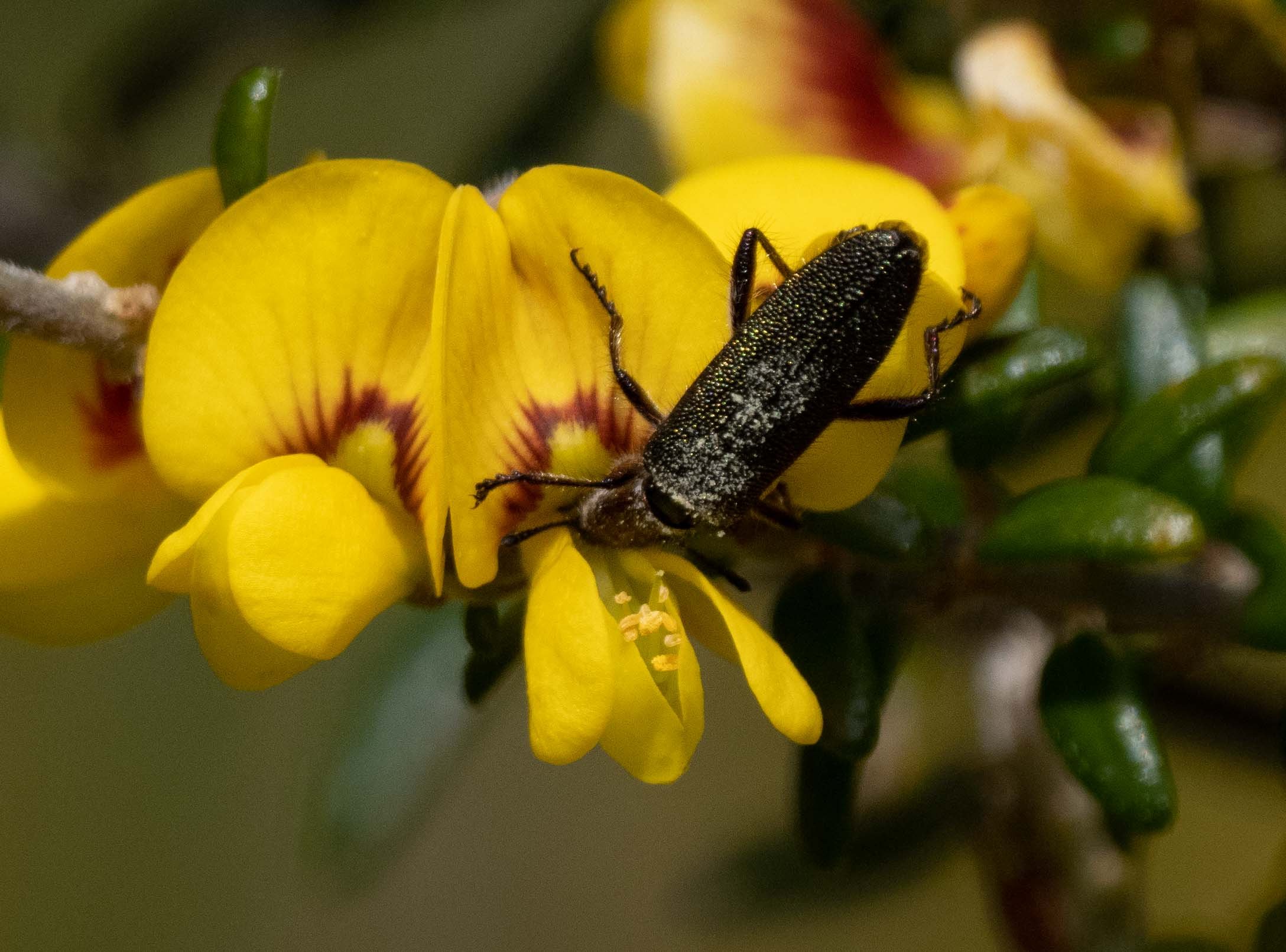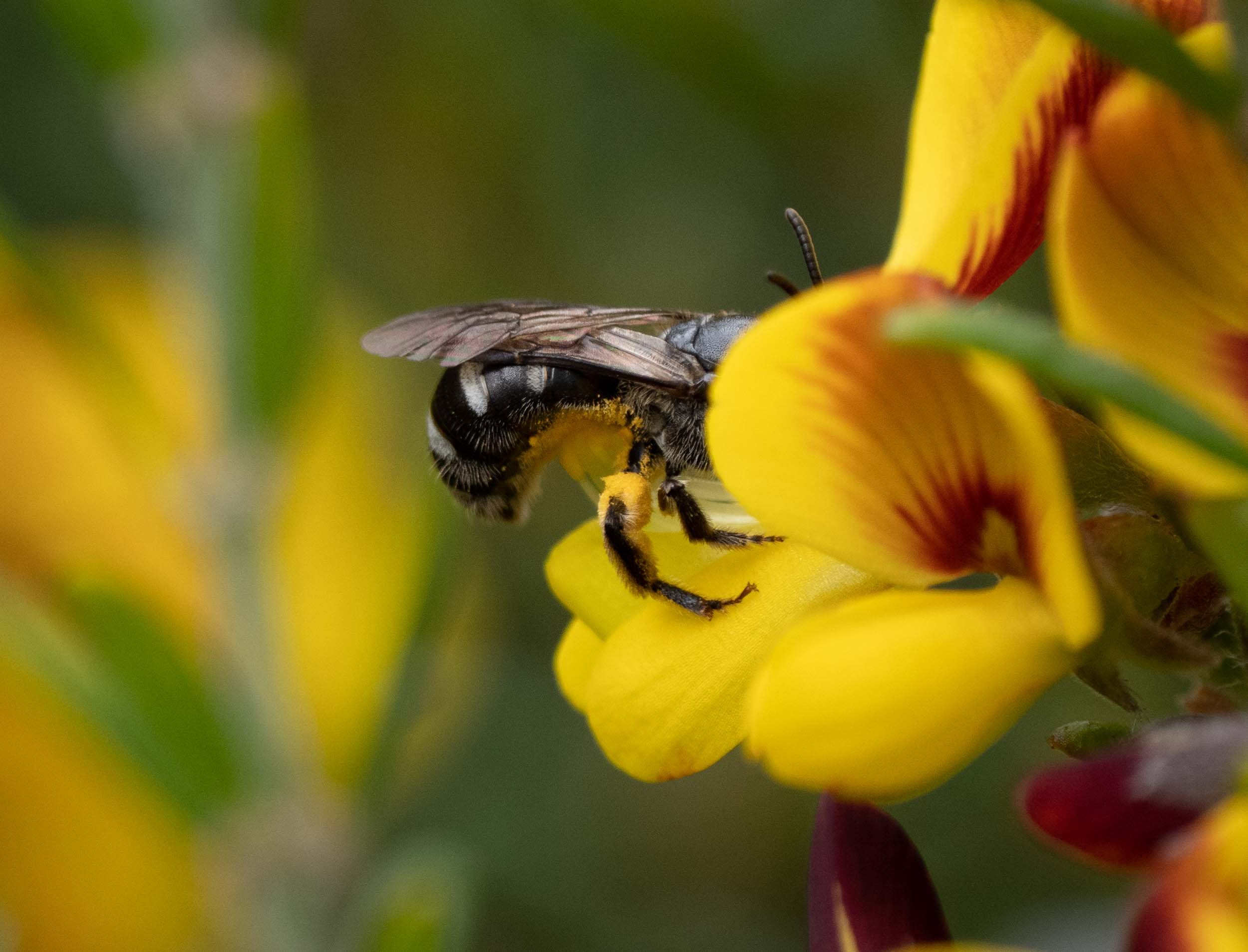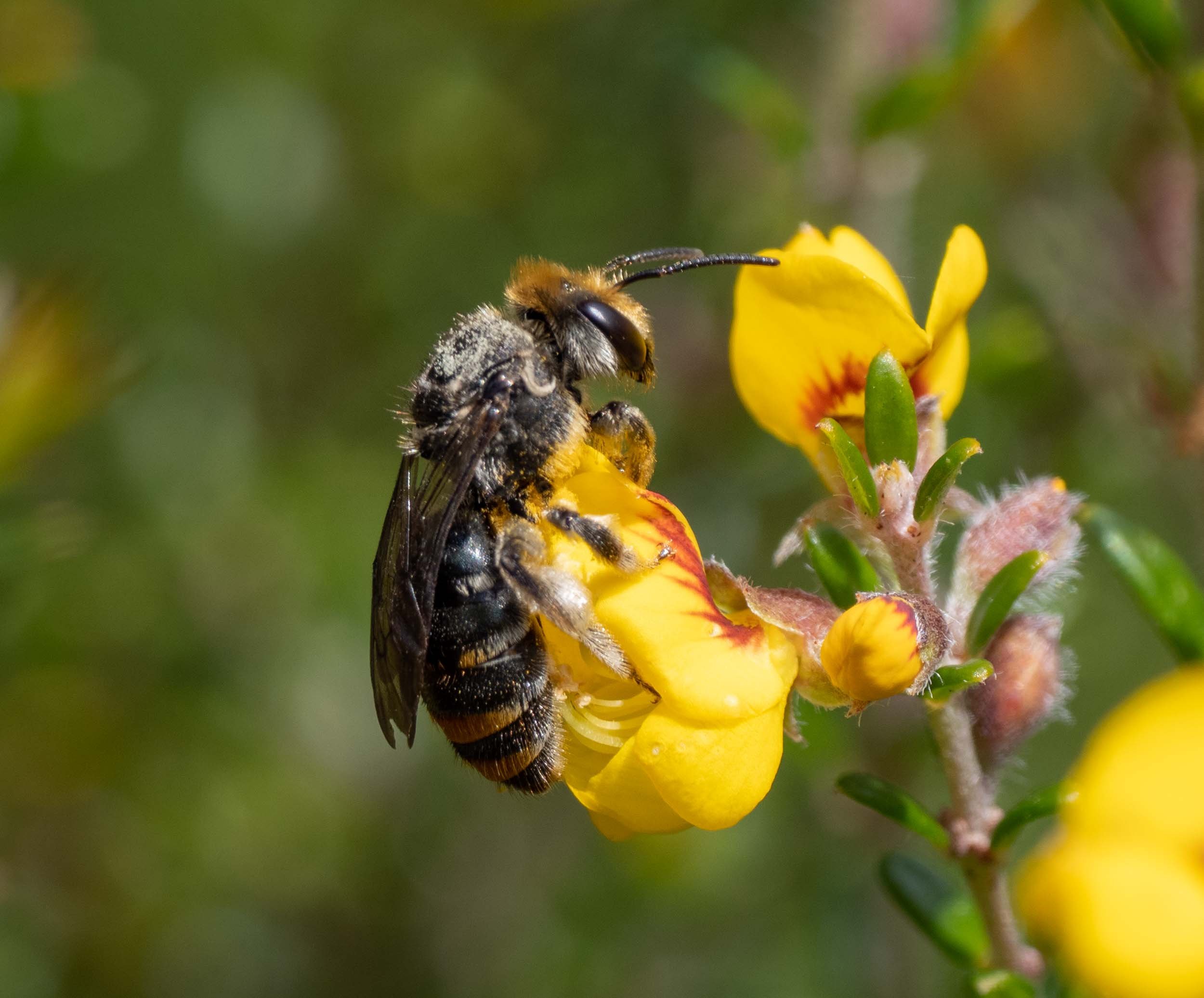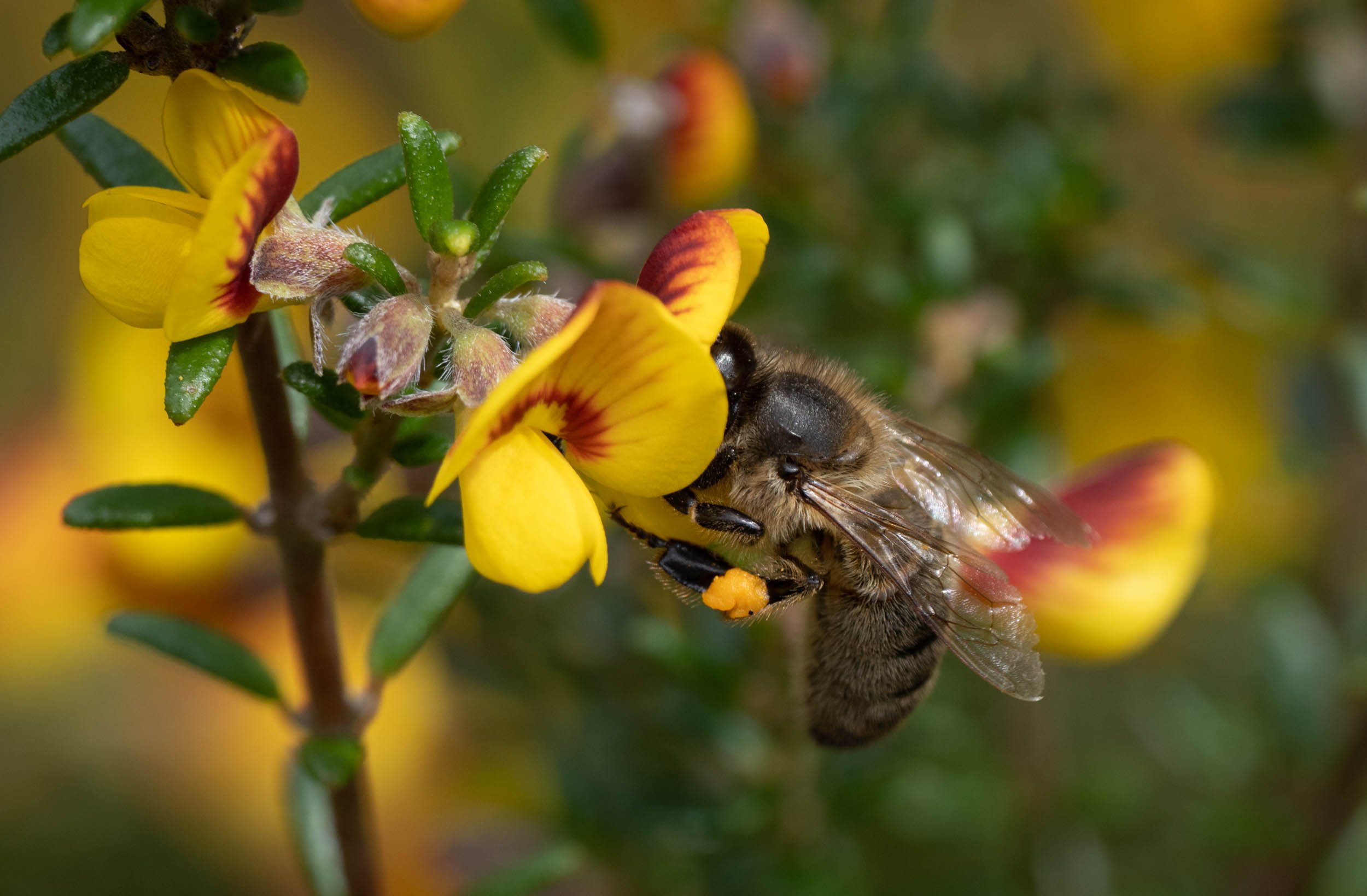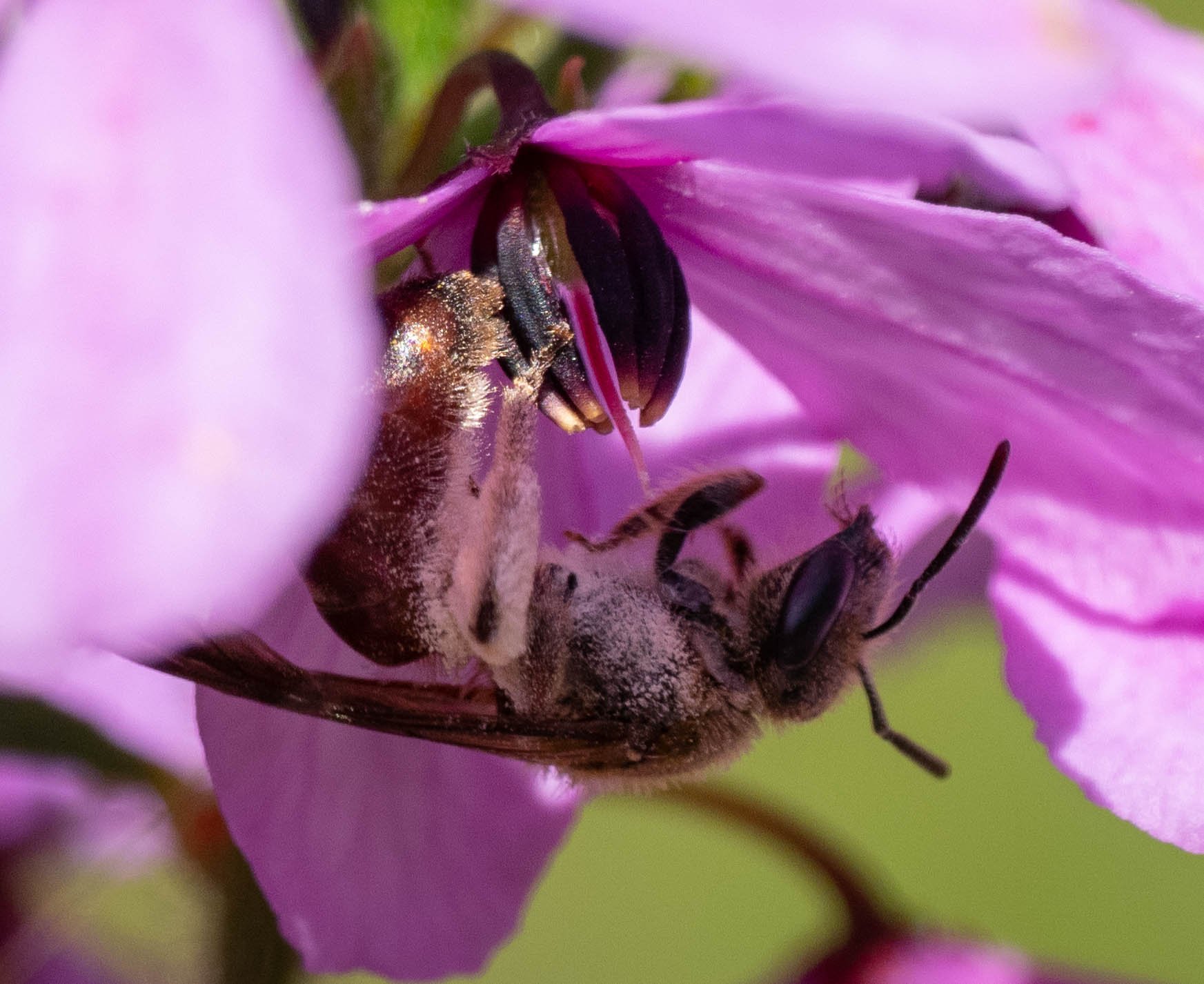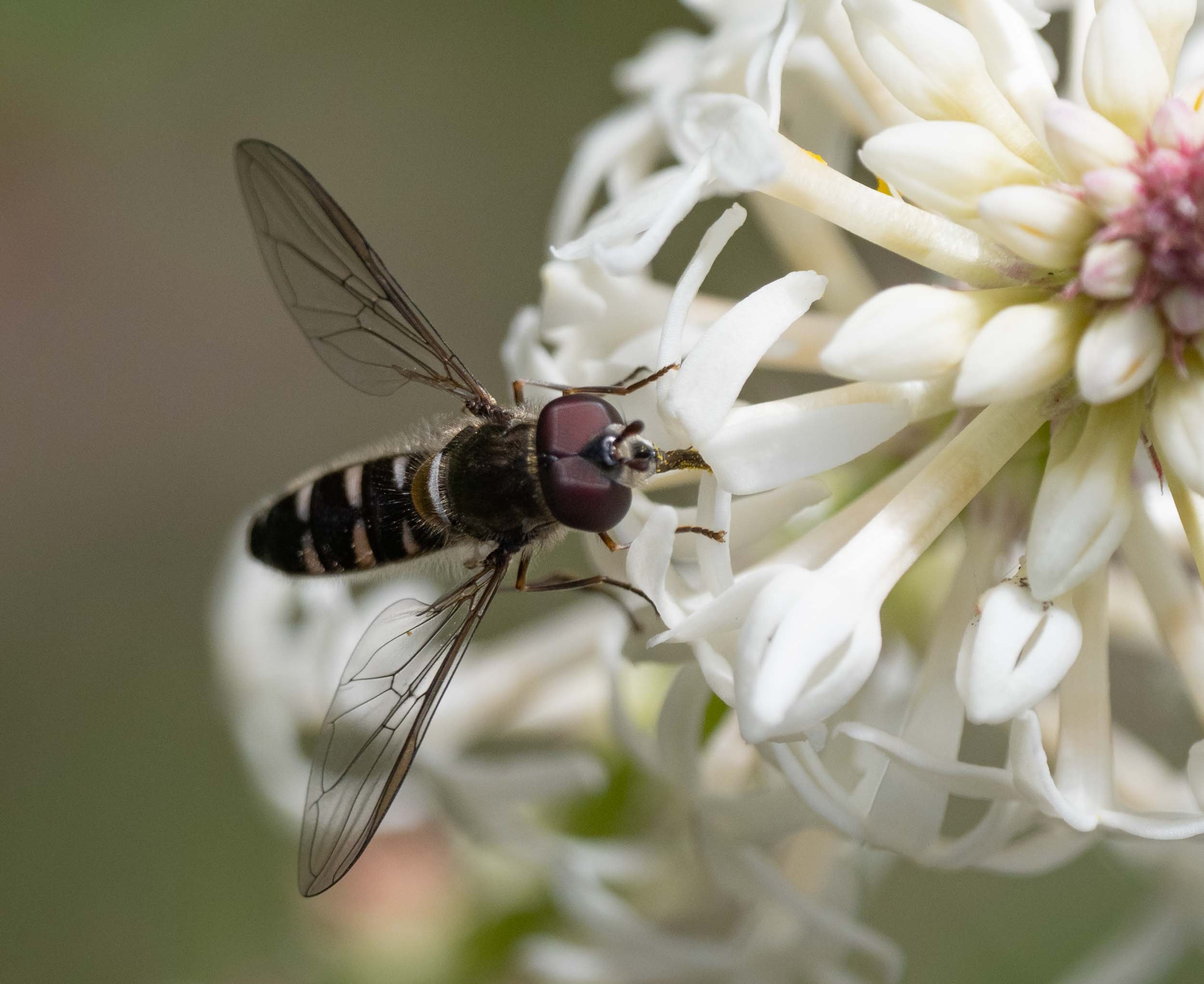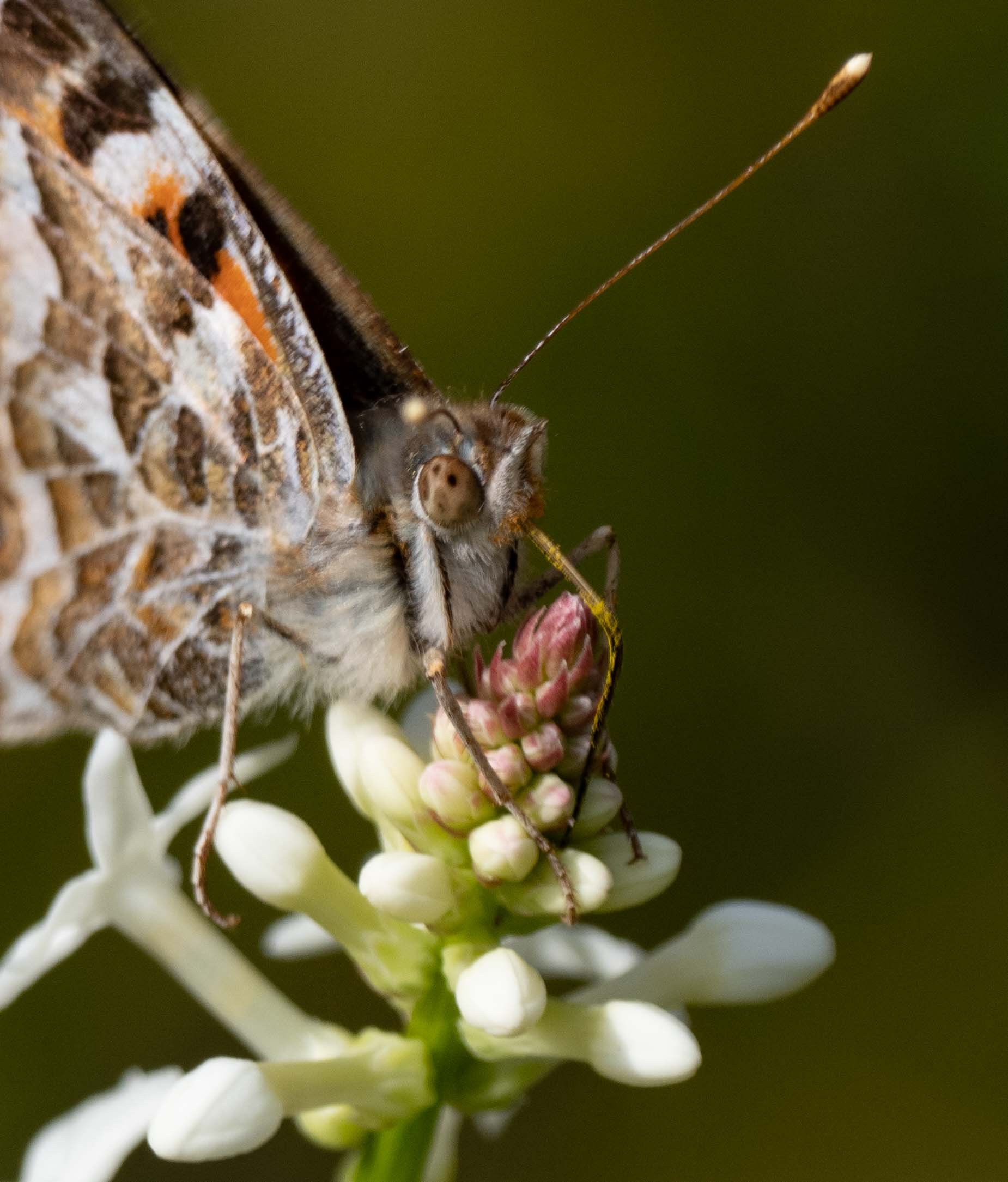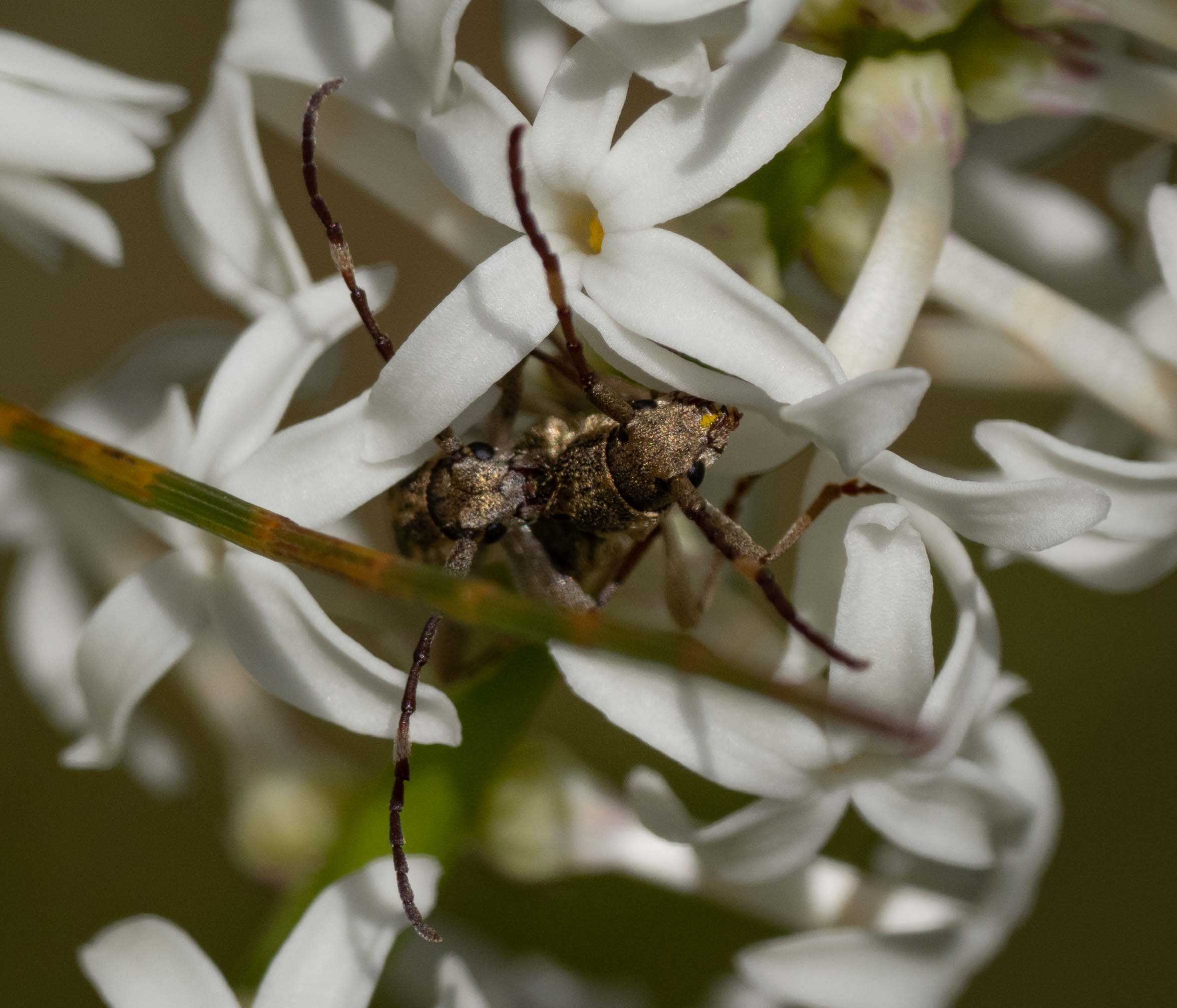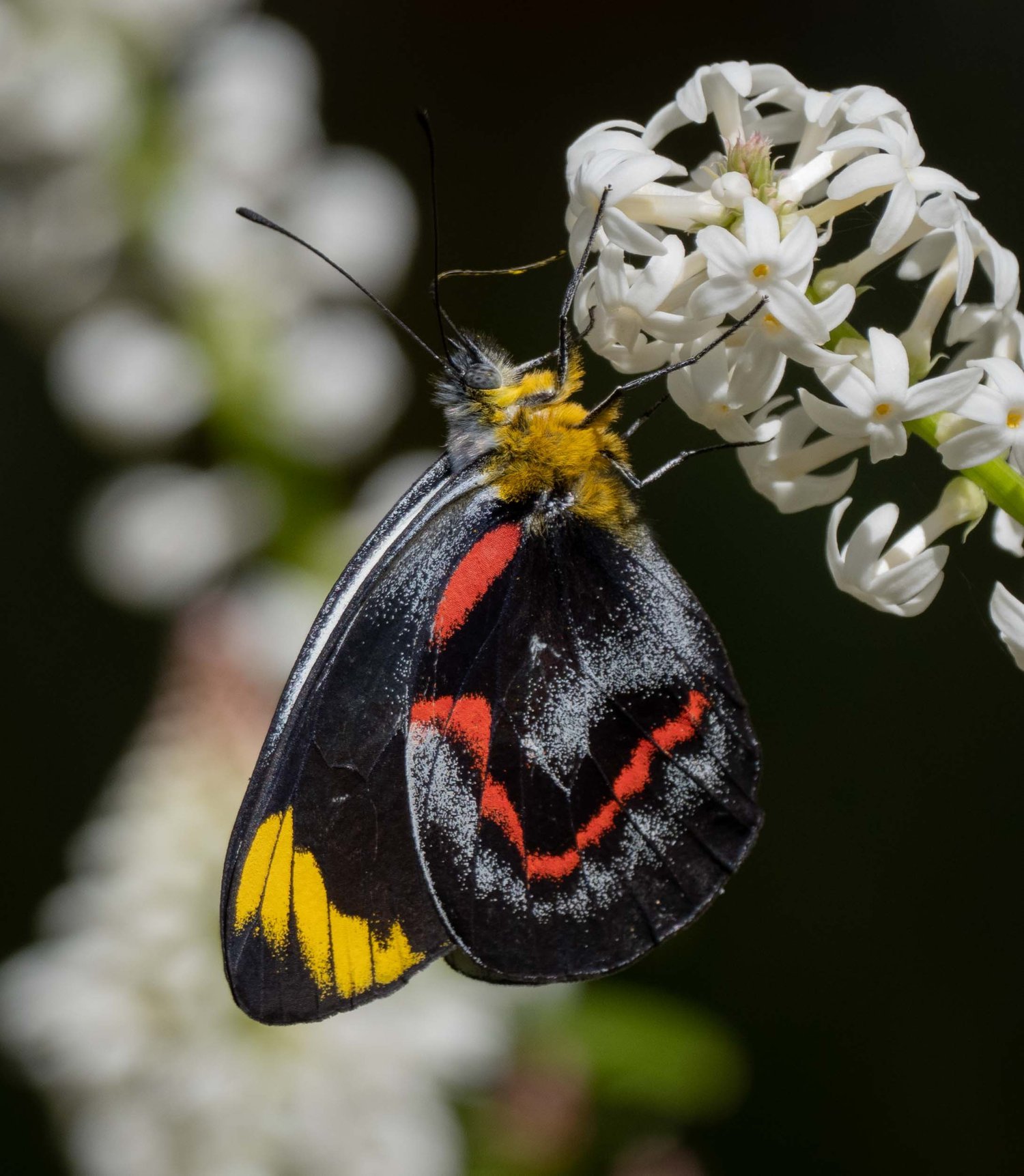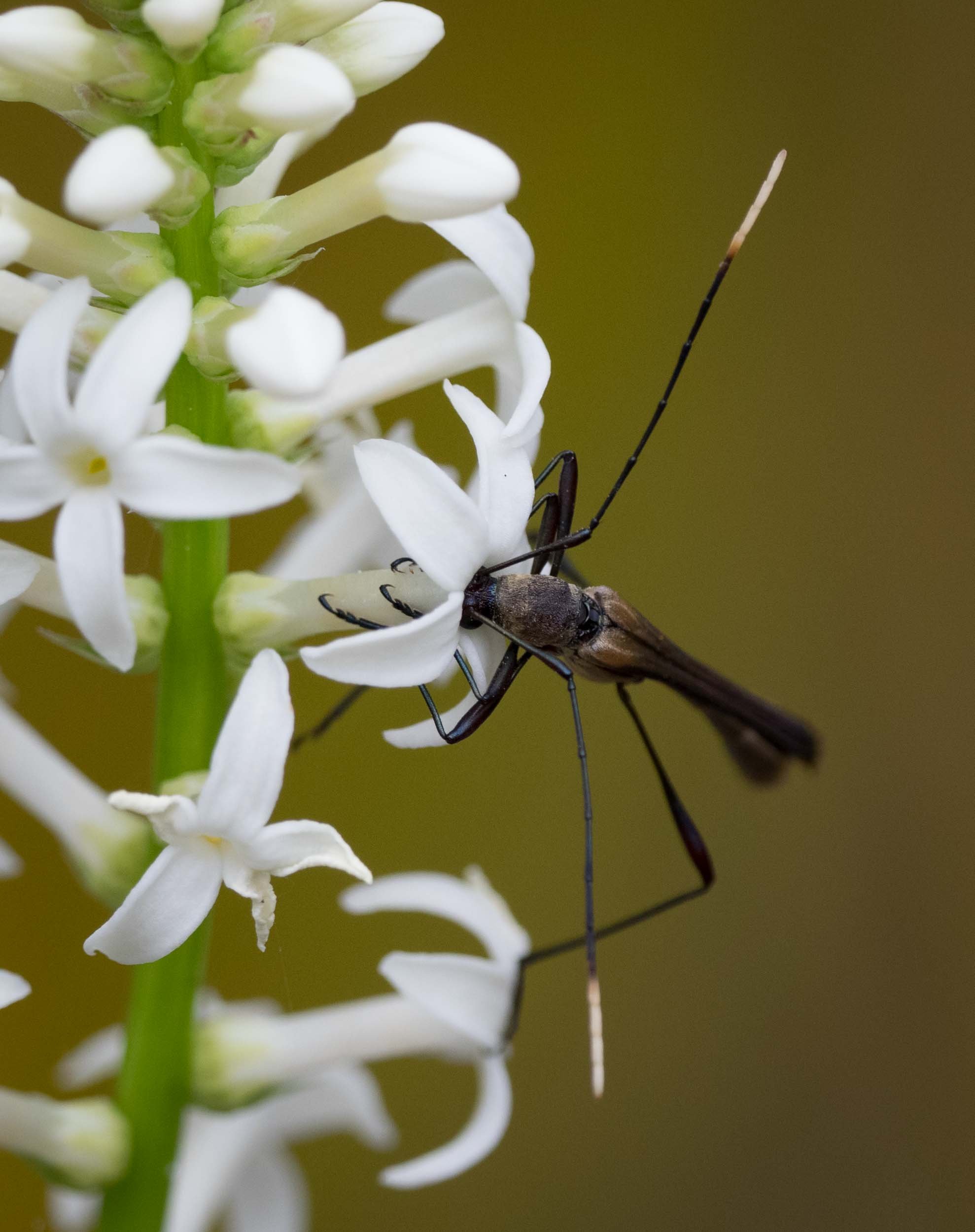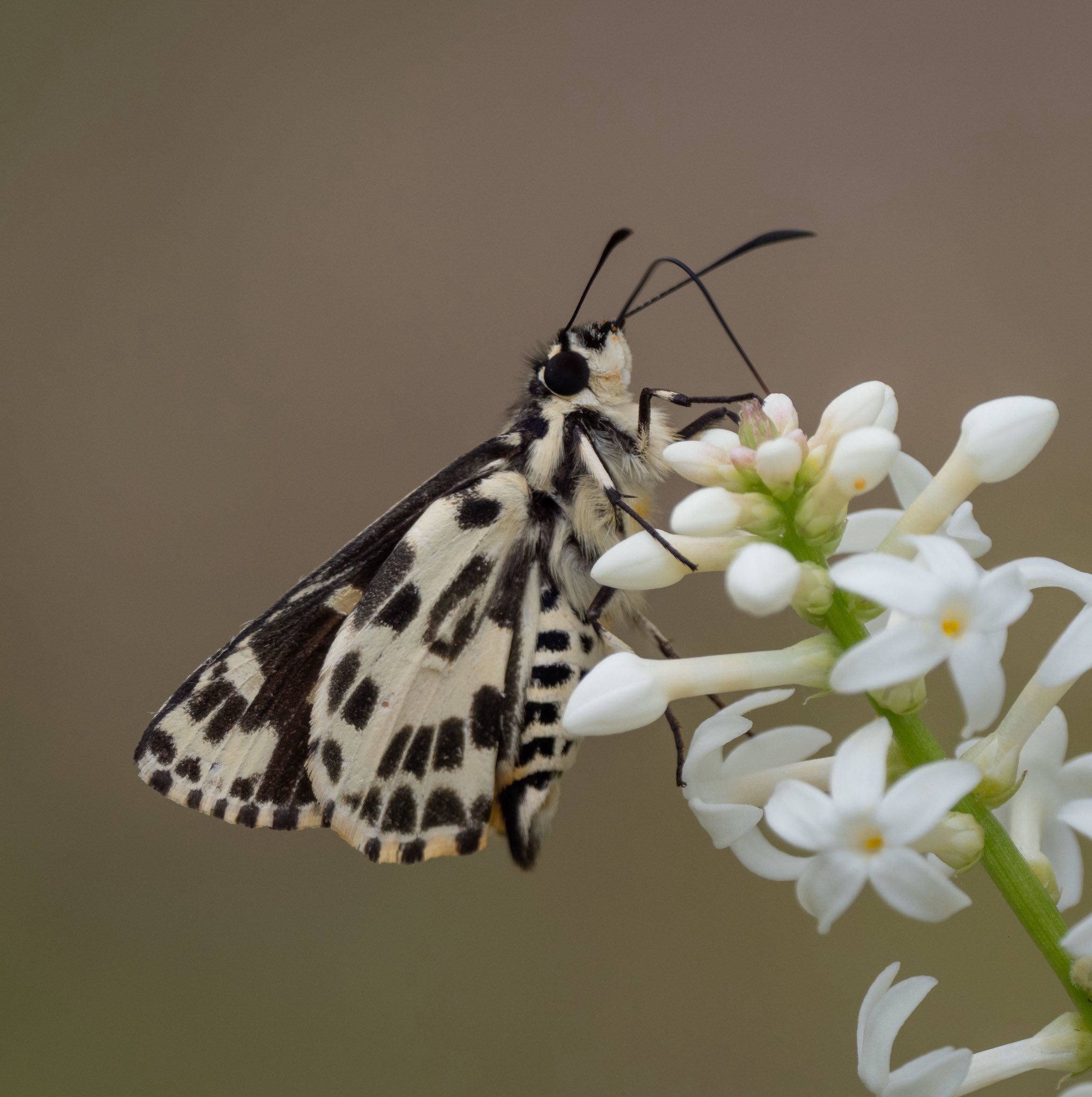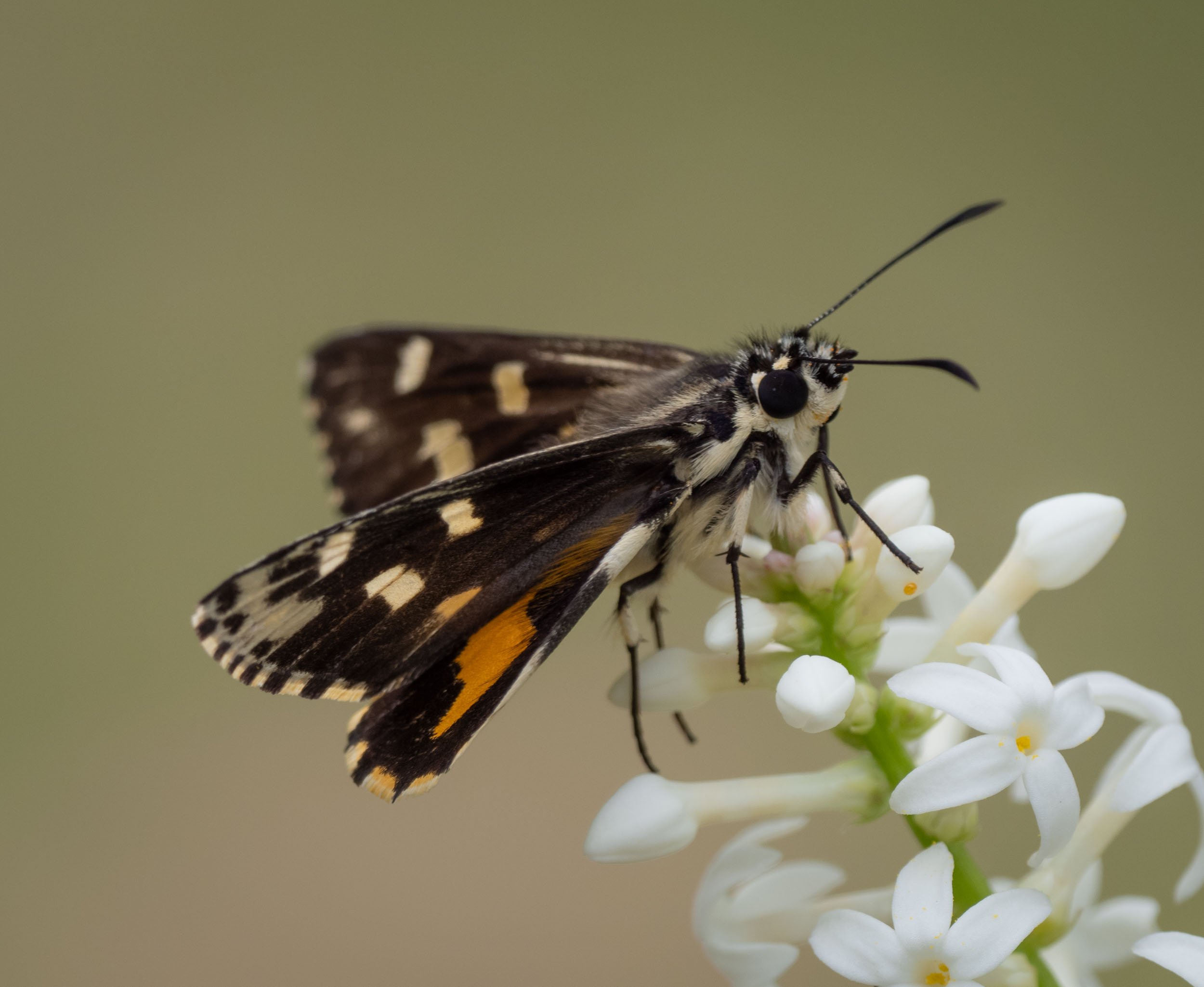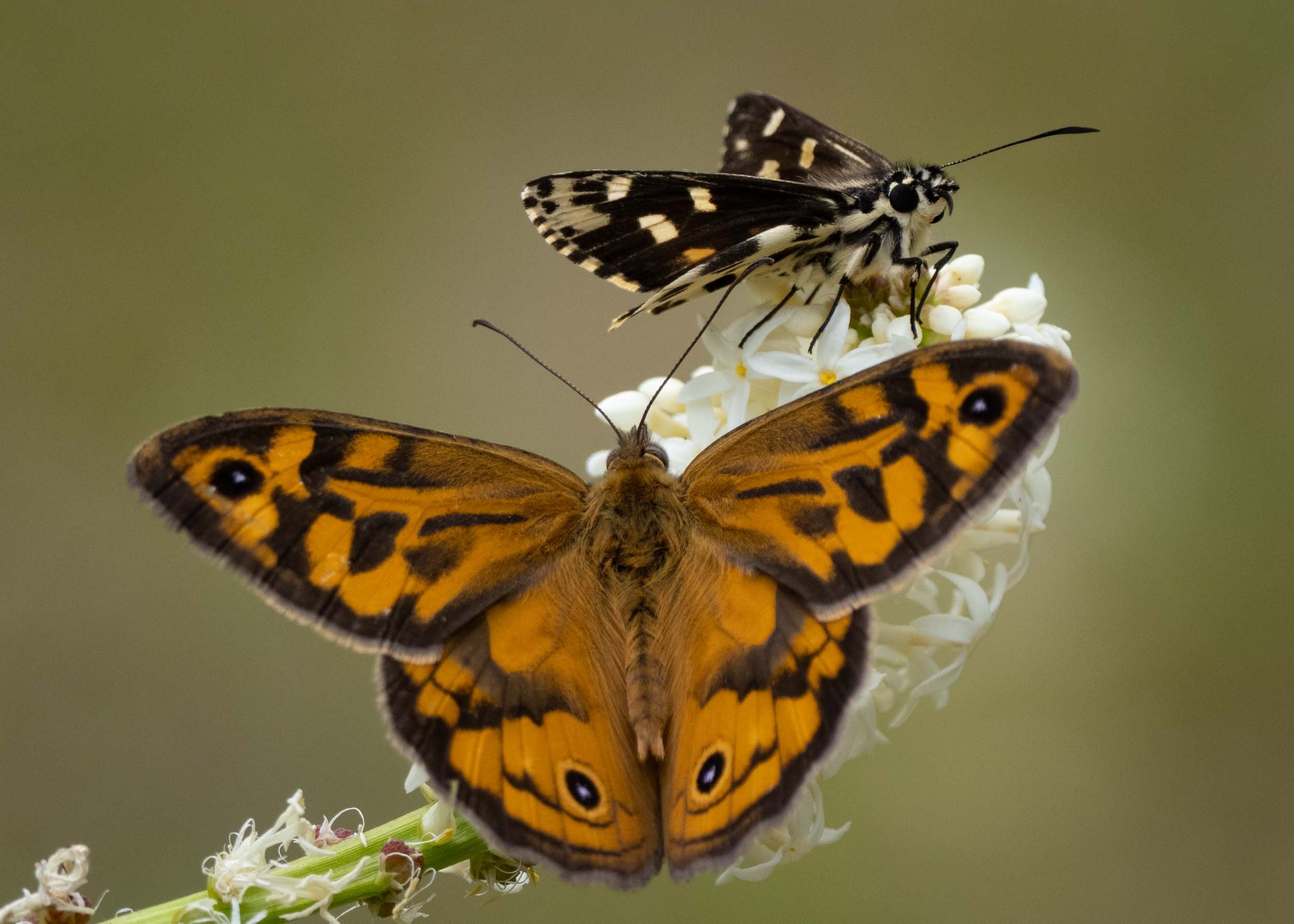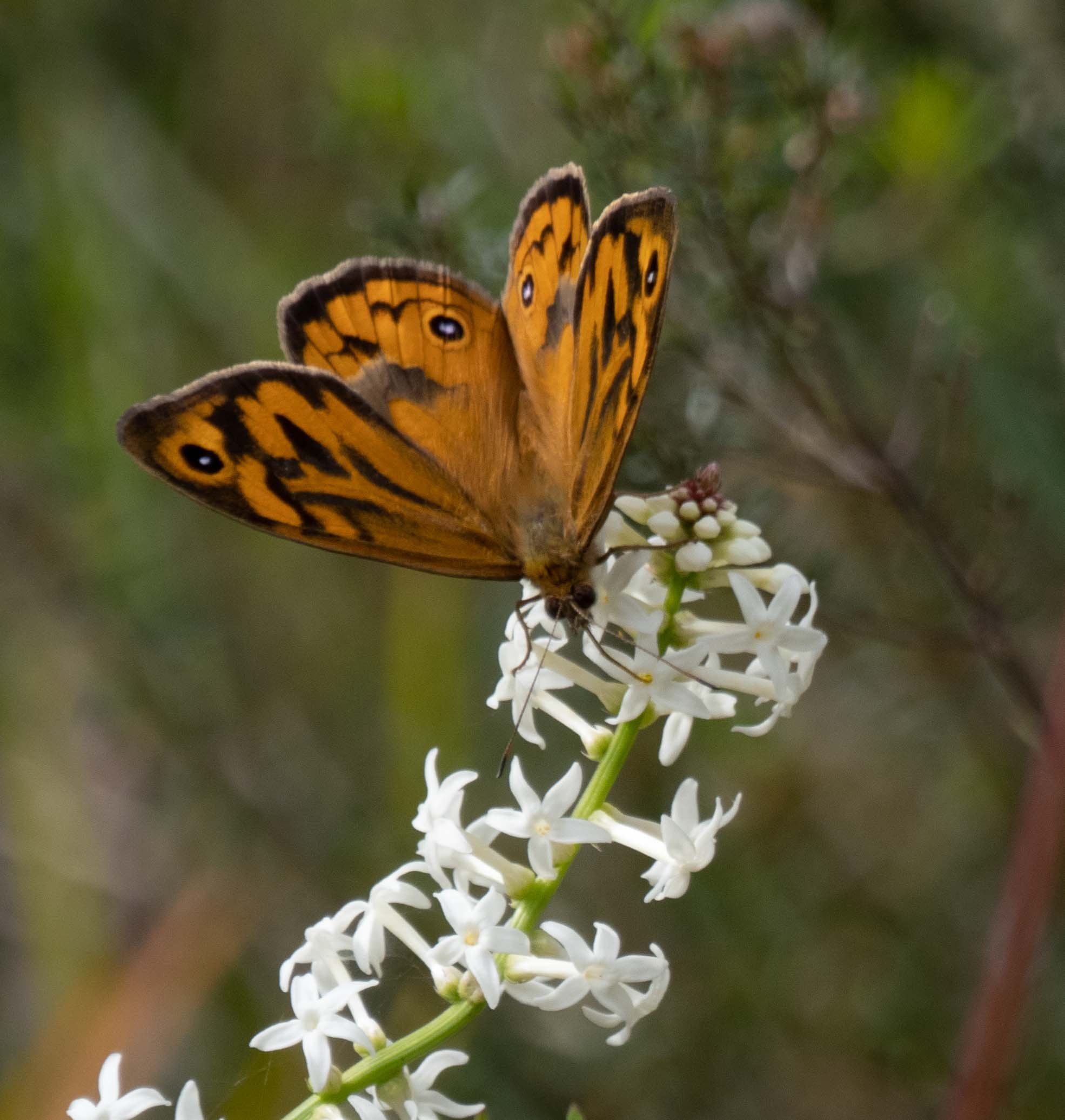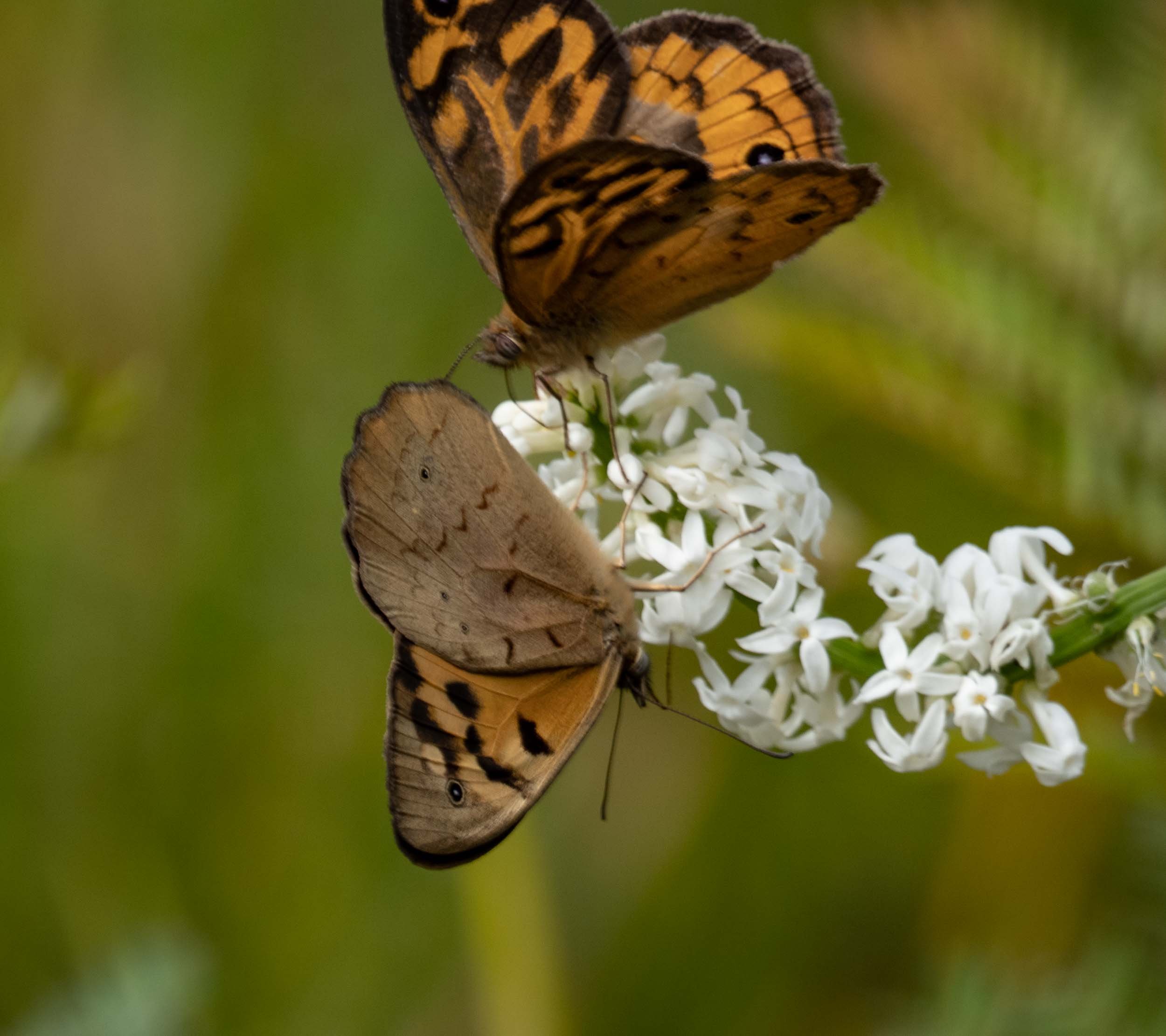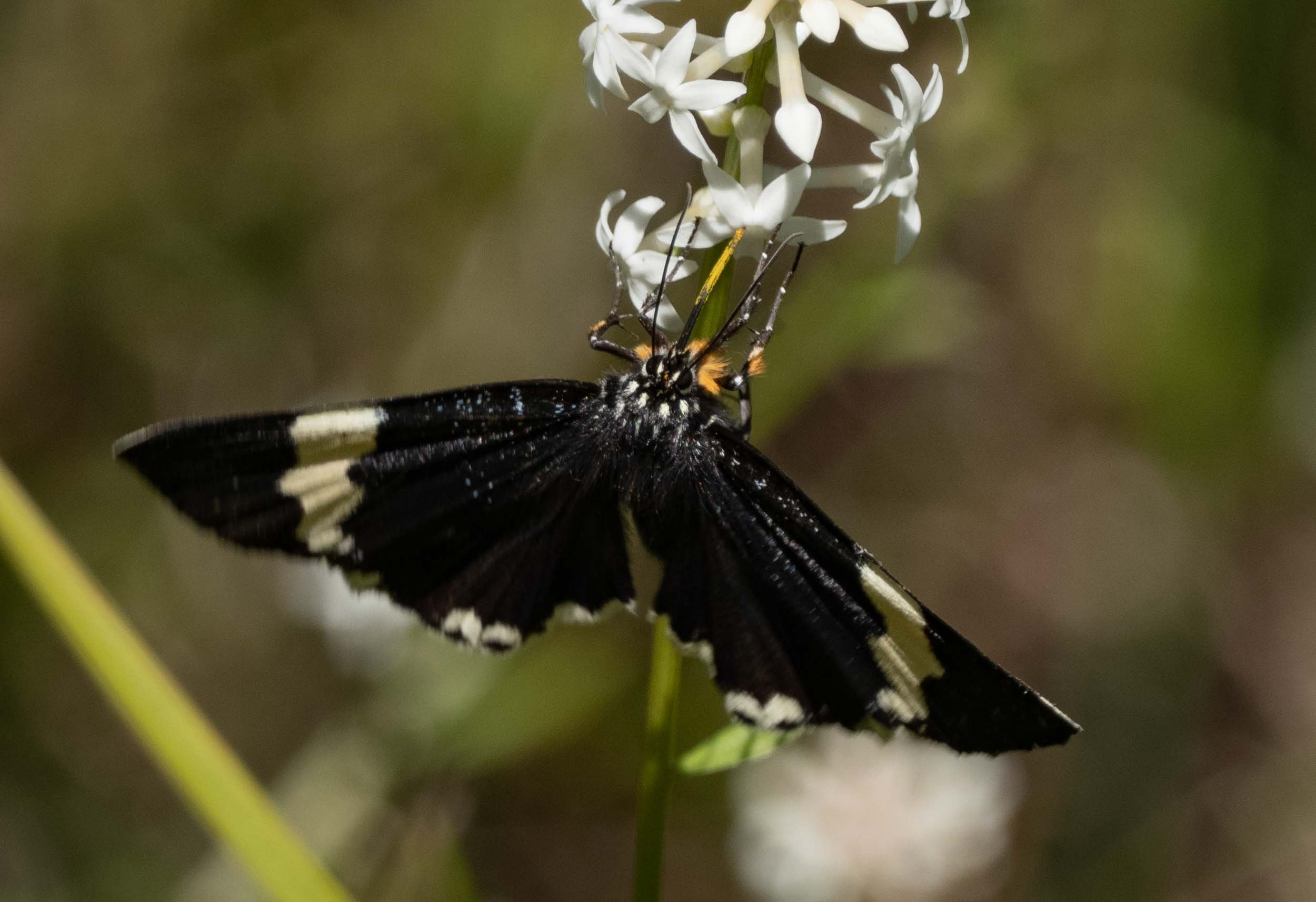Pollination puzzles
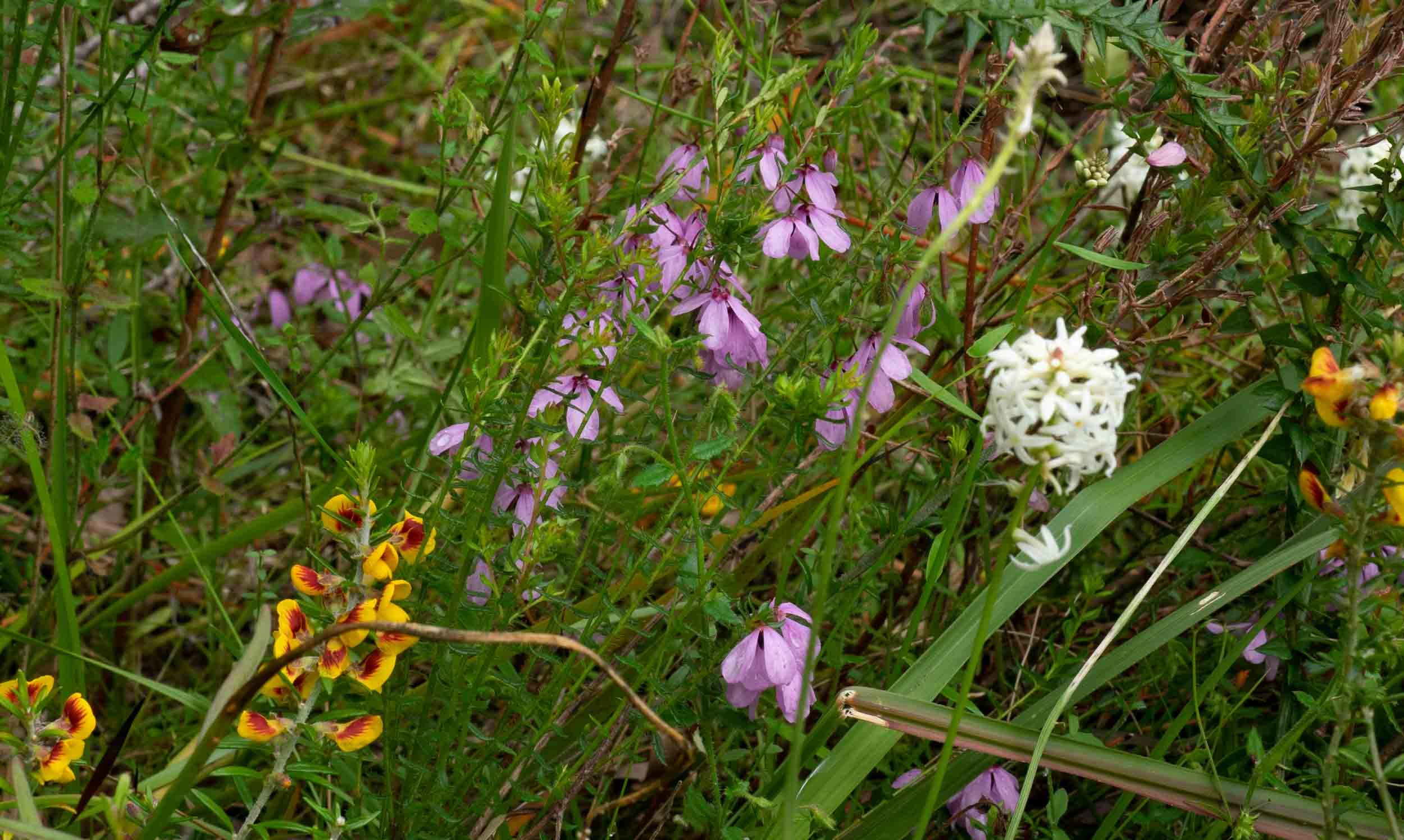
I’ve often wondered about the pollination of Tetratheca, or Pink Bells. These low-growing shrubs have a long flowering season: starting in mid August, peaking now (late October), and with many buds yet to open. But where are their pollinators?
Even now, with insect numbers growing daily, the beautiful lilac bells remain islands of calm in a hectic sea of yellow Aotus pea flowers.
Alongside the Aotus and Tetratheca are large stands of Stackhousia, or Creamy Candles. Again, where are all the insects? We occasionally see butterflies feeding on the flowers, and there is the odd beetle or perching fly. But who are the pollinators? Not bees, as they apparently ignore the pretty white flowers.
This week I decided to tackle both mysteries. So I’ve been photographing insects, dissecting flowers … and reading.
It turns out that Tetratheca, Stackhousia and Aotus employ very different pollination strategies. More surprising, however, was the dependence of Tetratheca on the neighbouring peas. And it all comes back to the bees.
First, a little bit of background
As adults, bees consume both nectar and pollen. Nectar mainly provides sugars, while pollen provides fats and proteins. Of course, this is true for many insects. Butterflies and some flies take nectar, while many beetles and some flies are predominantly pollen-feeders.
Female bees also collect pollen and nectar and transport it back to the nest as food for their larvae. This is a distinctive characteristic of bees, shared with very few other types of insects. There is a small family of wasps that do the same thing, but these ‘pollen wasps’ (family Masarinae) are not common in our part of Australia.
Some of our most common bees are generalists. That is, they are opportunistic and collect from a wide range of flowering plants. These include Lipotriches (e.g. Green-and-gold nomia bee), Amegilla (blue-banded bees), many Lasioglossum and Exoneura (Houston 2018). And the introduced Apis mellifera (European honeybee).
However, many of Australia’s solitary bees are more specialised. They feed almost exclusively from a limited range of plant taxa. Unsurprisingly, their flight times coincide with the flowering season of those particular plants. In our home forest, two obvious examples are Leioproctus specialising on Persoonia [read more here], and Trichocolletes specialising on Hardenbergia.
Flowers actively produce nectar as a reward for pollinators, regulating production both in timing and composition. Pollen, of course, has another purpose. And unlike pollen, nectar supplies can be replenished once they have been depleted by visiting insects.
Nectar is more than a simple sugar solution. It also contains various amino acids and other metabolites that can influence the foraging behaviour of insect visitors, including their preference for particular flowers (Nicolson 2022).
Plants have evolved various strategies to ensure successful cross-pollination, commonly by limiting the range of insects that can gain access to the floral resources. The ideal pollinator is one that reliably moves between plants of the same species, transporting pollen from the first plant to the receptive stigma of second. Bees and flowering plants have been coevolving in this way for more than 100 million years … so no wonder the relationships are many and varied!
Revisiting the familiar: pea flowers
Aotus ericoides is the latest in a succession of yellow flowering peas. First came Bossiaea, then various Pultenaea. But the Aotus is by far the most spectacular. The low bushes are widespread across the sunnier areas of the forest and their flowering is profuse. It is attracting a range of insects, but bees are clearly the most regular and successful visitors.
The clusters of yellow and red flowers of Aotus ericoides dominate the low shrub layer this month. Anyone familiar with this website will know that ‘peas and bees’ is a theme I’ve tackled before … but it’s worth another look. All photos below were taken this month in the natural garden of the forest floor.
Photo: 23/10/22
Like most pea flowers, Aotus has ‘keel blossoms’. The two lowermost petals envelop the filaments (with their pollen-bearing anthers) and the style (with its pollen-receptive stigma).
Perhaps surprisingly, given the strong association with bees, pea flowers are said to have evolved specifically to protect the pollen from foraging bees while at the same time taking advantage of bees as effective pollinators (Westerkamp 1997). The mechanism is complex, but the result is this:
To access the nectar, bees need to prise apart the upper petal (the ‘standard’) and the lower wing-keel complex.
This involves strength and technique … it’s not simply a case of being heavy enough, although heavier bees do tend to be stronger (Córdoba & Cocucci 2011). Interestingly, honey bees are particularly weak for their size. However, they do manage the Aotus flowers with ease.
And the flower shape is such that as the bee pushes, with its legs and mouth busily engaged, the stigma and anthers contact its underside.
Again, photos and animations tell the story:
Even with a slight movement of the wings, the keel opens and the anthers contact the base of the bee’s middle legs.
Exoneura (family: Apidae)
As soon as this bee stops pressing down on the wings, the keel covers the anthers again and the wings snap back into their original position. Almost. For a short time after having been tripped, the mechanism remains somewhat relaxed (Córdoba & Cocucci 2011).
Lasioglossum (family: Halictidae)
Having spread the wings and depressed the keel, the bee has (incidentally) exposed the inner parts of the flower. Note the elevation of the stigma which the bee is trying to push aside with one pollen-covered leg.
Exoneura (family: Apidae)
The keel is fully depressed, the filament column is visible, and the pollen-covered anthers are pressed against the ventral thorax of this Nomia Bee.
Lipotriches australica (family: Halictidae)
A female resting after her last nectar feed. Despite the careful packaging of pollen onto the specialised hairs on her hind legs, her other body hairs are still dusted with pollen grains. She is also ‘bubbling’ nectar from her crop, holding it between her outstretched mandibles to evaporate some of the water content.
Leioproctus (family: Colletidae) ?
As a pollination strategy, this works well for Aotus … and it works for the bees too. Although a female bee will comb much of the pollen from her body and store it as food for her larvae, some will inevitably remain in hard to reach places – and so be available for pollination. Also, she will visit multiple flowers during any single foraging trip away from the nest, accumulating (and spreading) a mix of pollen as she goes.
Male bees dusted with pollen will simply transfer it to the next pea flower they visit for nectar. They don’t package pollen, nor carry it to nests. But they can serve as pollinators.
The keel flower system is good, but not perfect. Some bees do still manage to get their mandibles and front legs to work on the anthers. Usually this follows a nectar meal, while the wings and keel are still relaxed – it takes time for the mechanism to fully reload.
The bees seem a bit awkward when working the anthers, straddling the keel sideways or clutching the filament bundle. Yet it clearly works.
Having already tripped the floral mechanism and exposed the anthers, this female bee grips the filaments with her mandibles and the floral wings with her back legs … and puts her other legs to work gathering pollen.
Lasioglossum (Halictidae)
Puzzle 1: Tetratheca
Tetratheca is bee pollinated too … but visits are rare and the technique is entirely different.
The first (and only) bee I have seen visiting Tetratheca pilosa.
[Photobombing this image is a katydid nymph. It may be responsible for some petal damage, but it isn’t capable of pollinating these flowers.]
She is a medium-sized halictine bee, Lasioglossum (subgenus: Parasphecodes). The long hairs on her back legs are already packed with pollen, while the rest of her body is dusted with the fine, white grains.
In all my time hanging about the natural flower garden of the forest floor, stalking insects, I can’t recall ever seeing a potential pollinator on Tetratheca. Until this week. In fact, this solitary female Lasioglossum was the catalyst for this blog. I clearly needed to know more about these little flowers and their insect visitors.
Watching her as she moved from flower to flower was memorable and felt rather special. And now that I have read up a bit, I realise just how special a moment it was. Native bees are the recognised pollinators of Tetratheca, but their visits are rare. Pollination researchers have spent hundreds of hours deliberately searching and yet have made relatively few sightings such as this!
Gross and colleagues spent nearly 100 hours in the field specifically searching Tetratheca juncea flowers north of Sydney and did not see a single bee (Gross et al. 2003). In a replicate study, Driscoll also searched for a total of 100 hours but in longer intervals (2-3 hours cf. 15-25 mins in the Gross study), with a little more success (Driscoll 2003). Driscoll recorded an average of one bee approaching the flowers every two hours, although only eight bees were observed actually collecting pollen. In a 1999 study looking at affinities of different bee species with Tasmanian plants, foraging bees in three vegetation communities were sampled: coastal heath, dry sclerophyll forest and subalpine forest (Higgins 1999). A total of 500 bees were collected over 63 days of field work … and only three were found foraging on Tetratheca.
So, back to the flower. Tetratheca does not provide nectar and the pollen is hard to get at. The thick-walled, tubular anthers don’t split open at maturity. Each has an apical pore and as pollen matures and dries near the tip, restricted amounts become available for release.
Bees must hang upside down and vibrate the anthers to shake the pollen out through the small pore at the tip. The pollen grains are fine, the amount limited, the perch precarious.
Why Tetratheca needs Aotus
Bees need nectar but Tetratheca doesn’t provide it. Instead, it capitalises on the nectar-filled flowers of nearby plants (Higgins 1999; Gross et al. 2003). Here in the forest, Aotus ericoides is doing the job nicely … attracting generalist bees and providing them with ample nectar. Occasionally one of these bees will switch to Tetratheca for a time, and that is all it takes.
With so few visits by pollinators, how does Tetratheca survive? Individual plants are quite long-lived, spreading clonally through offshoots. No seed needed for that.
However, seed is needed for dispersal and for genetic mixing.
Tetratheca flowers rarely self-pollinate (based on studies of Tetratheca juncea by Gross et al. 1999), perhaps due to the retention of pollen inside the anther, and the tiny stigma. So to set seed and to gain the population benefits of sexual reproduction, Tetratheca depends upon the occasional visit from a native bee.
A single plant, with multiple stems. Tetratheca is a perennial shrub, producing additional stems from underground rhizomes, year after year.
And it appears to be working!
Today I went looking for fruit and was pleasantly surprised to find many enlarged ovaries on lengthened peduncles, petals shed. I assume this signifies successful fertilisation.
Ovary growth. A & B: petals and 2 anthers removed for imaging. C: the individual fruit arrowed in the next photo. Collected and imaged: 27/10/22
Large numbers of young, developing fruit on this Tetratheca pilosa indicate successful cross fertilisation.
(Arrow indicates the individual fruit labeled C in the ovary growth figure alongside)
Image: 26/10/22
At maturity each fruit will split and release two seeds. The seeds are 2-3mm long and bear an elaiosome … an ant-attracting structure (Thompson 1976). Some seeds will be collected by ants, the elaiosome consumed, and the remaining, intact seed discarded or buried … often in a protected place where it may eventually germinate. Remember those Funnel Ants I wrote about recently?
Puzzle 2: Stackhousia
Stackhousia monogyna is visited by various insects, although it never draws a crowd. In seeking to uncover its pollination secrets, insect-watching offered some clues … but the floral anatomy provided the most compelling evidence.
A single flowering stem of Stackhousia monogyna can produce dozens of flowers. New buds form at the tip even as older flowers below are maturing into fruit. Each flower comprises a long, tubular corolla fringed by five free petal lobes. The yellow tips of stamens are just visible inside the mouth of the tube.
Unlike the peas and Tetratheca, there is little published research on the pollination strategy of Stackhousia. Some authors cite the nocturnal fragrance as an attraction for moths, but I’ve yet to unearth any detailed studies.
A knowledgable friend recently reminded me of this pollination puzzle (thanks for the prompt Roger) – and since then I’ve been closely watching the flowers, on the lookout for likely candidates. I’ve even been dropping by at night. While I can confirm that their scent is quite heady after dark, I have yet to encounter any fellow nocturnal visitors.
What I can say is that the bees seem completely disinterested. Large clusters of Stackhousia are blooming immediately alongside flowering Aotus, yet I’ve not seen a single bee visit the white flowers. Perhaps this is predictable … the Stackhousia monogyna nectar is at the base of a narrow floral tube, 6-7mm long. Even the largest, long-tongued bees would struggle. Some of the pollen is easily accessible, but most of it is held deep inside the tube. And there’s not a lot of it.
Some insects do feed at the flowers. Butterflies and moths probe deep for nectar – no problem for an insect with such a long, fine proboscis! There is the occasional visit from a feeding fly or beetle. Yet there are remarkably few insects of any type. Despite my deliberate searching, I’ve made just a handful of sightings. By trawling our photographic records from past seasons I’ve added a few more examples – but still not many.
Notwithstanding the scant evidence and paucity of sightings, it seems safe to accept butterflies and moths as the best candidates for the job of Stackhousia pollinators.
The long, narrow proboscis is perfectly suited to reaching the nectar.
The shape and location of the stigma also seems perfect for wiping pollen from the tip of a probing lepidopteran tongue.
White flowers that are most fragrant at night … yet another hint that moths are involved.
Hoverflies can reach the anthers, but not the stigma. The same is true for beetles, even the long-nosed, longhorn beetle Enchoptera. When foraging on Stackhousia, these insects can best be described as pollen thieves rather than pollinators.
Circumstantial evidence and inference, I know, but it’s a start.
References
Córdoba, S.A. & Cocucci, A.A. 2011. Flower power: its association with bee power and floral functional morphology in papilionate legumes. Annals of Botany 108: 910-913
Driscoll, C. Pollination ecology of Tetratheca juncea (Tremandraceae): finding the pollinators. Cunninghamia 8(1): 133-140
Gross, C.L., Bartier, F.V. & Mulligan, D.R. 2003. Floral structure, breeding system and fruit-set in the threatened sub-shrub Tetratheca juncea (Tremandraceae). Annals of Botany 92: 771-777
Hingston, A.B. 1999. Affinities between southern Tasmanian plants in native bee visitor profiles. Australian Journal of Zoology 47: 361-384
Houston, T. 2018. A Guide to Native Bees of Australia. CSIRO Publishing, Clayton South Vic.
Nicolson, S.W. 2022. Sweet solutions: nectar chemistry and quality. Phil. Trans. R. Soc. B. 377: 20210163. https://doi.org/10.1098/rstb.2021.0163
Ślipiński, A. & Escalona, H.E. 2013. Australian Longhorn Beetles (Coleoptera: Cerambycidae) Vol. 1. CSIRO Publishing, Melbourne.
Thompson, J. 1976. A revision of the genus Tetratheca (Tremandraceae). Telopea 1(3): 139-215
Vallejo-Marín, M. 2022. How and why do bees buzz? Implications for buzz pollination. Journal of Experimental Botany 73(4): 1080-1092 https://doi.org/10.1093/jxb/erab428 open access
Westerkamp, C. 1997. Keel blossoms: bee flowers with adaptations against bees. Flora 192: 125-132








